FIND THE INDICATED ANGLE IN THE PARALLELOGRAM WITH DIAGONALS
Find the measure of the indicated angle in each parallelogram.
Example 1 :
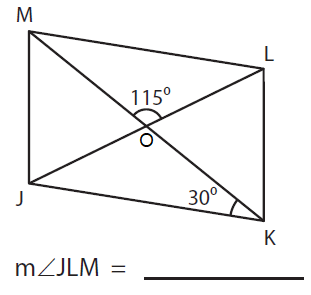
Solution :
In the given figure, ∠JKM = 30° and ∠MOL = 115°
By alternate angles,
∠JKM = ∠KML
30° = ∠KML
In ΔLOM,
We know that,
The sum of the interior angles of a triangle is 180°.
That is,
∠O + ∠M + ∠L = 180°
We have,
∠O = 115°, ∠M = 30°, and ∠L = ?
115° + 30° + ∠L = 180°
145° + ∠L = 180°
∠L = 180° - 145°
∠L = 35°
Now, ∠L = 35°. It is similar to m ∠JLM.
So, m ∠JLM = 35°
Example 2 :
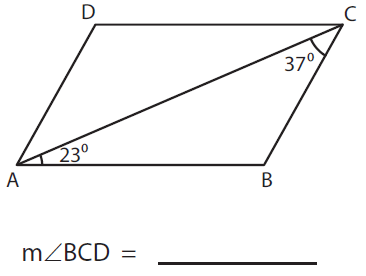
Solution :
In the given figure, ∠BAC = 23° and ∠BCA = 37°
By alternate angles,
∠BAC = ∠ACD
23° = ∠ACD
Now, ∠BCA = 37° and ∠ACD = 23°
To find ∠BCD,
∠BCD = ∠BCA + ∠ACD
= 37° + 23°
∠BCD = 60°
So, m ∠BCD = 60°.
Example 3 :
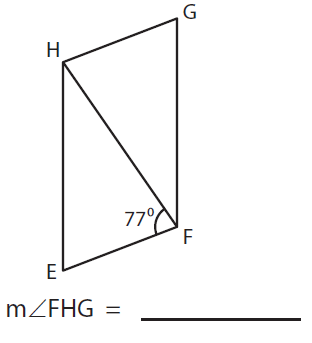
Solution :
In the given figure, ∠EFH = 77°
By alternate angles,
∠EFH = ∠FHG
77° = ∠FHG
So, m ∠FHG = 77°.
Example 4 :
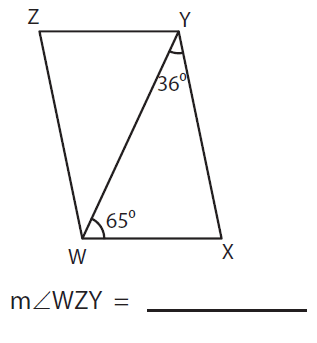
Solution :
In the given figure, ∠XWY = 65° and ∠XYW = 36°
By alternate angles,
|
∠XWY = ∠WYZ 65° = ∠WYZ |
∠XYW = ∠YWZ 36° = ∠YWZ |
In ΔWZY,
The sum of the interior angles of a triangle is 180°.
∠YWZ + ∠WYZ + ∠WZY = 180°
We have,
∠YWZ = 36°, ∠WYZ = 65°, and ∠WZY = ?
36° + 65° + ∠WZY = 180°
101° + ∠WZY = 180°
∠WZY = 180° - 101°
∠WZY = 79°
So, m ∠WZY = 79°.
Example 5 :
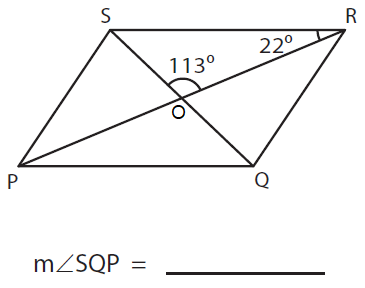
Solution :
In the given figure, ∠PRS = 22° and ∠SOR = 113°
By alternate angles,
∠PRS = ∠RPQ
22° = ∠RPQ = ∠OPQ
By vertically opposite angles,
∠SOR = ∠QOP
113° = ∠QOP
In ΔPOQ,
The sum of the interior angles of a triangle is 180°.
∠OPQ + ∠QOP + ∠OQP = 180°
We have,
∠OPQ = 22°, ∠QOP = 113°, and ∠OQP = ?
22° + 113° + ∠OQP = 180°
135° + ∠OQP = 180°
∠OQP = 180° - 135°
∠OQP = 45° = ∠SQP
So, m ∠SQP = 45°.
Example 6 :
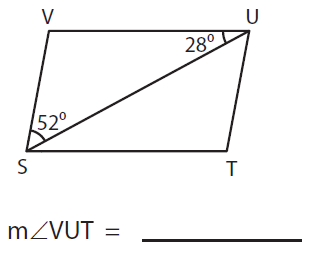
Solution :
In the given figure, ∠VSU = 52° and ∠VUS = 28°
By alternate angles,
∠VUS = ∠UST
28° = ∠UST
To find ∠VUT,
∠VUT = ∠VUS + ∠UST
= 52° + 28°
∠VUT = 80°
So, m ∠VUT = 80°.
Find the value of each variable in the parallelogram.
Example 7 :
Find the indicated measure in ▱LMNQ. Explain your reasoning.
|
a) LM b) LP c) LQ d) MQ |
e) m∠LMN f) m∠NQL g) m∠MNQ h) m∠LMQ |
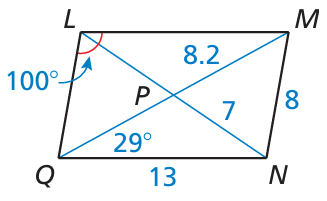
Solution :
a) LM = 13
b) LP = 7
c) LQ = 8
d)
MQ = 2(MP)
= 2(8.2)
= 16.4
e) Since LQ and NM are parallel, m∠QLM and m∠LMN co-interior angles.
m∠QLM + m∠LMN = 180
100 + m∠LMN = 180
m∠LMN = 180 - 100
m∠LMN = 80
f) LM and QN are parallel, then m∠NQL and m∠QLM
m∠NQL + m∠QLM = 180
m∠NQL + 100 = 180
m∠NQL = 180 - 100
= 80
g) m∠MNQ = 100 (Opposite angles are equal)
h) m∠LMQ = m∠LMN/2
= 80/2
= 40
Example 8 :
In ▱STUV, m∠TSU = 32°, m∠USV = (x2)°, m∠TUV = 12x°, and ∠TUV is an acute angle. Find m∠USV.
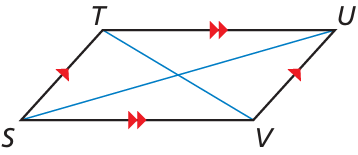
Solution :
m∠TSU = 32°, m∠USV = (x2)°
m∠TSV = m∠TUV (opposite angles are equal)
m∠TSU + m∠USV = m∠TUV
32 + x2 = 12x
x2 - 12x + 32 = 0
x2 - 8x - 4x + 32 = 0
x(x - 8) - 4 (x - 8) = 0
(x - 8) (x - 4) = 0
x = 8 and x = 4
m∠USV = 82 ==> 64
or
m∠USV = 42 ==> 16
Example 9 :
In the diagram of the parking lot shown, m∠JKL = 60°, JK = LM = 21 feet, and KL = JM = 9 feet.
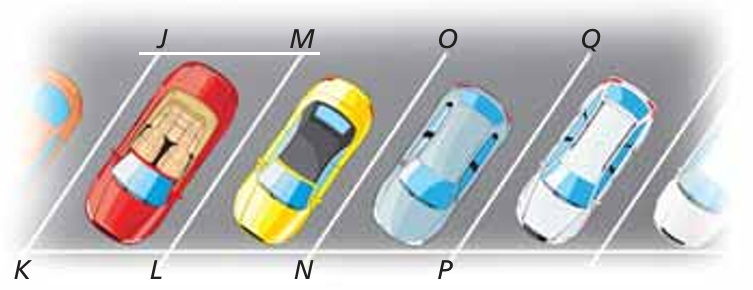
a. Explain how to show that parking space JKLM is a parallelogram.
b. Find m∠JML, m∠KJM, and m∠KLM.
c. LM || NO and NO || PQ . Which theorem could you use to show that JK II PQ ?
Solution :
a) JK = LM = 21 feet, and KL = JM = 9 feet.
Since opposite sides are equal, then it must be parallelogram.
b) Find m∠JML, m∠KJM, and m∠KLM.
m∠JKL = 60° = m∠JML
m∠JKL + m∠KJM = 180
60 + m∠KJM = 180
m∠KJM = 180 - 60
m∠KJM = 120°
c. Given that LM || NO and NO || PQ, then JK II PQ
Example 10 :
Prove the Parallelogram Opposite Angles Converse. (Hint: Let x ° represent m∠A and m∠C. Let y° represent m∠B and m∠D. Write and simplify an equation involving x and y.) Given ∠A ≅ ∠C, ∠B ≅ ∠D Prove ABCD is a parallelogram.
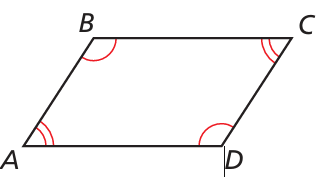
Solution :
Given that,
m∠A = m∠C = x°
m∠B = m∠D = y°
m∠A + m∠B + m∠C + m∠D = 360
m∠A + m∠C + m∠B + m∠D = 360
x + x + y + y = 360
2x + 2y = 360
2(x + y) = 360
x + y = 360/2
x° + y° = 180°
Co-interior angles add upto 180, then the sides AD and BC are parallel. Then ABCD is a parallelogram.
Recent Articles
-
Finding Range of Values Inequality Problems
May 21, 24 08:51 PM
Finding Range of Values Inequality Problems -
Solving Two Step Inequality Word Problems
May 21, 24 08:51 AM
Solving Two Step Inequality Word Problems -
Exponential Function Context and Data Modeling
May 20, 24 10:45 PM
Exponential Function Context and Data Modeling